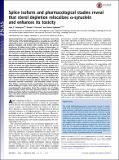Splice isoform and pharmacological studies reveal that sterol depletion relocalizes -synuclein and enhances its toxicity
Author(s)
Termine, Daniel J.; Lindquist, Susan; Valastyan, Julie Suzanne
DownloadValastyan-2014-Splice isoform and p.pdf (2.759Mb)
PUBLISHER_POLICY
Publisher Policy
Article is made available in accordance with the publisher's policy and may be subject to US copyright law. Please refer to the publisher's site for terms of use.
Terms of use
Metadata
Show full item recordAbstract
Synucleinopathies are neurodegenerative diseases associated with toxicity of the lipid-binding protein α-synuclein (α-syn). When expressed in yeast, α-syn associates with membranes at the endoplasmic reticulum and traffics with vesicles out to the plasma membrane. At higher levels it elicits a number of phenotypes, including blocking vesicle trafficking. The expression of α-syn splice isoforms varies with disease, but how these isoforms affect protein function is unknown. We investigated two of the most abundant isoforms, resulting in deletion of exon four (α-synΔ4) or exon six (α-synΔ6). α-SynΔ4, missing part of the lipid-binding domain, had reduced toxicity and membrane binding. α-SynΔ6, missing part of the protein–protein interaction domain, had reduced toxicity but no reduction in membrane binding. To compare the mechanism by which the splice isoforms exert toxicity, equally toxic strains were probed with genetic modifiers of α-syn–induced toxicity. Most modifiers equally altered the toxicity induced by the splice isoforms and full-length α-syn (α-synFL). However, the splice isoform strains responded differently to a sterol-binding protein, leading us to examine the effect of sterols on α-syn–induced toxicity. Upon inhibition of sterol synthesis, α-synFL and α-synΔ6, but not α-synΔ4, showed decreased plasma membrane association, increased vesicular association, and increased cellular toxicity. Thus, higher membrane sterol concentrations favor plasma membrane binding of α-synFL and α-synΔ6 and may be protective of synucleinopathy progression. Given the common use of cholesterol-reducing statins and these potential effects on membrane binding proteins, further investigation of how sterol concentration and α-syn splice isoforms affect vesicular trafficking in synucleinopathies is warranted.
Date issued
2014-02Department
Massachusetts Institute of Technology. Department of Biology; Whitehead Institute for Biomedical ResearchJournal
Proceedings of the National Academy of Sciences
Publisher
National Academy of Sciences (U.S.)
Citation
Valastyan, J. S., D. J. Termine, and S. Lindquist. “Splice Isoform and Pharmacological Studies Reveal That Sterol Depletion Relocalizes -Synuclein and Enhances Its Toxicity.” Proceedings of the National Academy of Sciences 111, no. 8 (February 10, 2014): 3014–3019.
Version: Final published version
ISSN
0027-8424
1091-6490